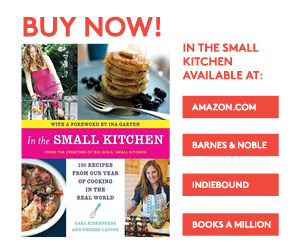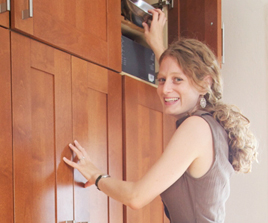Send Help: We’re Planting a Small Kitchen Garden
For the last two summers, we’ve been members of a CSA. The twice-monthly vegetable deliveries have kept us feasting healthfully on the most seasonal stuff without a lot of effort. But this year, with a new very sunny roof deck attached to our apartment, we decided to try something different.
We’re planting vegetables.
I jumped in with a two-session course about small space gardening at the NYBG last month, which made me feel simultaneously overwhelmed and excited. Now that the soil’s warming up, we’re solidifying plans and browsing seed catalogs. Here’s what we’re going to do:
- Get two EarthBoxes. These containers were recommended for their drainage abilities in particular. It’s going to get really hot up on the roof, and we’ll have to water a lot. With good drainage, we won’t have to worry about drowning our plants. We’re putting the containers on casters, so we can move them around the roof til we find the best location with respect to sun and wind. Our landlords also left some containers-there are chives (see them in between the Adirondack chairs?) surprising us in one!-so we may make use of those, too.
- Keep the rest of the equipment to a minimum. Small kitchen, small shed. So far, the list is: gloves, soil thermometer, watering can, popsicle sticks (for labeling), hose, organic potting soil, and organic fertilizer. And seeds. Later in the season, we’ll figure out supplies for trellising, should our beans or tomatoes make it that far. The idea is also to keep the budget in check and avoid the $64 tomato problem.
- Plant radish and carrot seeds in the containers before we leave for a two-week trip in late April. If it rains while we’re gone, maybe we’ll be on our way to early radishes. If the plants wither, we’ll plant again when we return, plus add herbs and greens. What gardeners know and I’ve just discovered is that you have to embrace trial and error. So this will be my first exercise.
- Prioritize low-energy plants with a short time to harvest. I’d never thought about veggies this way before the course, but it makes so much intuitive sense. Plants grow roots and leaves first, then spend more energy to develop flowers (broccoli, for example) and fruits (like peppers). So if there’s a plant where you eat the roots and leaves (carrots, radishes, lettuces), you’ll be able to harvest more quickly. That also means there’s less time for things to go wrong. I’m still going to try planting some pole beans, cherry tomatoes, and peppers once a few small harvests of roots and leaves have actually come up.
Do you have a garden? Any tips? I’d love to hear any thoughts about starting out, not getting frustrated, and acquiring a green thumb.
P.S. The simplest way to prepare spring’s first radishes and scallions.
-
http://theleftoversproject.com/ Megan and Joe
-
http://theblogbloom.com Claire Trost
-
Candis Scott

 Corn Muffins with Corn, Hot Peppers & Scallions
Corn Muffins with Corn, Hot Peppers & Scallions 


